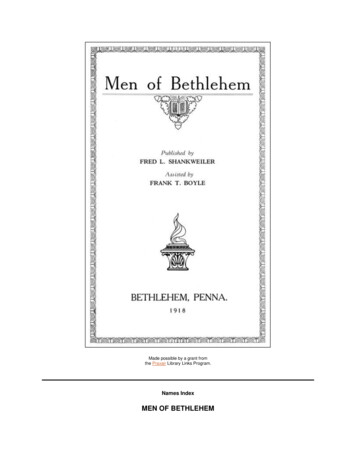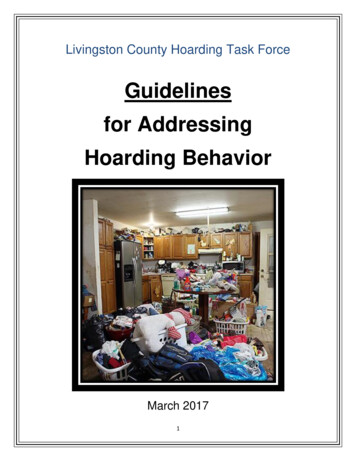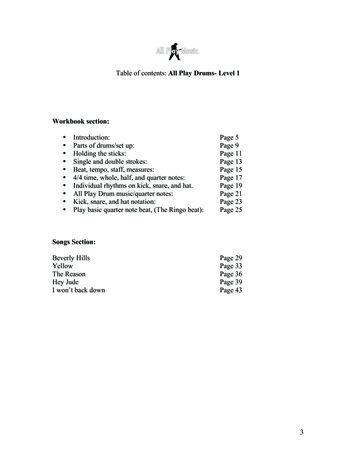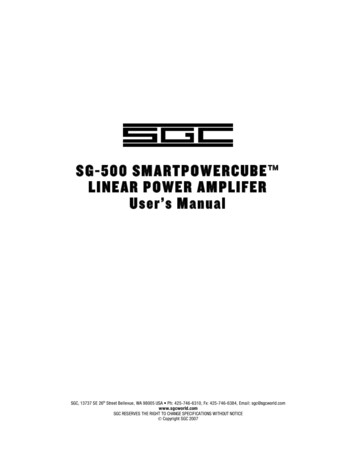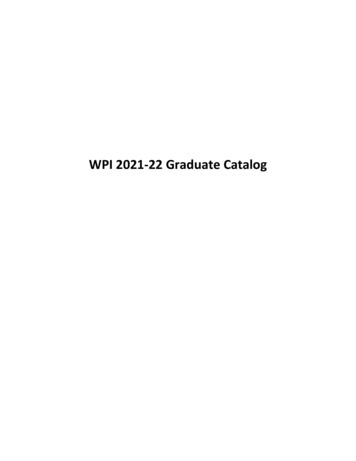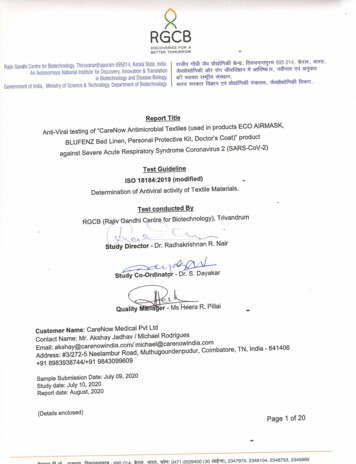
Transcription
OVERVIEW1. ObjectiveThe objective of this document is to provide data on antiviral efficacy of CareNow AntimicrobialTextiles, when tested against SARS-CoV-2 using International Standard of ISO 18184(Determination of the antiviral activity of the textile products against specified viruses)2. About Rajiv Gandhi Center of BiotechnologyRajiv Gandhi Center for Biotechnology is an autonomous body of the Department ofBiotechnology, Government of India. RGCB is a leading research institution located inTrivandrum, Kerala, India and is involved in Fundamental Research, Technology Development,Translational Science, Education & Intellectual Property development in the field ofBiotechnology.3. DescriptionCareNow Antimicrobial textiles are reusable textile products that have permanently bonded antimicrobial technology to provide a germ free and clean surface on textiles. The anti-microbialtechnology works round the clock and provides a barrier of protection against bacteria, fungiand encapsulated virus by inhibiting the growth in textiles.The science behind the technology is a unique treatment of textile with a permanently lastinganti-microbial technology. The treatment on the textile provides cationic sites with a longmolecular chain of carbon atoms with a vely charged Nitrogen attached to a Silica Atom that iscovalently bonded to the fabric. Bacteria, Fungi and Encapsulated Viruses are negativelycharged. The cationic sites present on the fabric attract, bind and disrupt the cell membranes ofthe micro-organisms and provides continuous anti-microbial activity.In this report, a study of Antimicrobial efficacy of CareNow Antimicrobial Textiles was performedas per ISO 18184:2019 (modified). A regular untreated Textile fabric is used as a controlsample. This international standard specifies testing methods for determination of the antiviralactivity of the submitted textile samples. CareNow Antimicrobial Textiles are intended to beused in products such as ECO AIRMASK, BLUFENZ Bed Linen, Personal Protective Kit,Doctor’s Coat.Page 2 of 19
In this test, the antiviral activity of one of the CareNow Antimicrobial Textiles and UntreatedTextiles was identified by inoculating with E and S gene of Severe acute respiratory syndromecoronavirus 2 (SARS-CoV-2) with 120 minutes of treatment time and the samples wereevaluated by analyzing the reduction of viral load in percentage. The sample color is notrepresentative of the entire gamut of colors that are offered for different end uses but essentiallyrepresents the technology and efficacy of antiviral property of textile4. SummaryThe test method involves the inoculation of SARS-CoV-2 viral genes (E gene and S gene) on tothe test sample (CareNow Antimicrobial Textiles & Untreated Textiles). In 120 minutes oftreatment time, viral load on the samples were observed at the time frequency of 0, 30, 45, 60and 120 minutes. Proceeding with neutralization to retrieve the inoculated SARS-CoV-2 viralgenes. The retrieved RNA content was evaluated by performing qRT-PCR technique for furtherconfirmation of antiviral activity of the selected test sample.5. Result Summary:Sr.No12Time(min)4560CareNow AntimicrobialTextileReduction in Viral Load %E GeneS Gene 95 959999Untreated TextileReduction in Viral Load %E GeneS GeneNSNSNSNSWhere, NS: Non-SignificantFor detailed tabulated result, refer appendix 3, Tabular representation of viral reduction rate6.Inference & Conclusion1. In the present study, SARS-CoV-2 specific RNA (E&S target gene) was not detectedafter 45 minutes of contact time, indicating rupturing of viral envelope with 95% ofreduction in viral load in test sample whereas the Control sample of Untreated Textileexhibited Not Significant reduction of Viral Load.2. It has also significantly enhanced the antiviral log reduction and reduces viral infectivityby 99% reduction of viral load in 60 minutes of contact time.3. It indicates, test sample (CareNow Antimicrobial Textiles) shows effective antiviralactivity against encapsulated SARS-CoV-2 virus within 45 minutes of contact time.Page 3 of 19
Picture of SampleControl SamplesPage 4 of 19
CONTENTS:1.ISO 18184:2019 (modified) test procedure Appendix 1a.b.c.d.e.PrincipleMaterials / Apparatus requiredTest isolateDetails of test sample and control samplesTest procedure2.qRT-PCR for quantitative analysis of RNA Appendix 2a.b.c.d.Sample preparationMixture and Reaction setupDyesResult Interpretation3.Test results - Test product against SARS-CoV-2 Appendix 3a.Raw data of CareNow Antimicrobial Textiles and Untreated Textiles sample against E andS GeneTabular representation of viral reduction rateInferenceQuality Controlb.c.d.Page 5 of 19
APPENDIX 1ISO 18184:2019 (modified) test procedurea)Principle:The viruses are inoculated to a specimen. After specific contacting time, the remaininginfectious virus is counted, and the reduction rate is calculated by the comparison betweenantiviral test specimen and the reference (control) specimen by common logarithm.b) Materials / Apparatus / Chemicals required:Test sample:CareNow Antimicrobial TextilesTest organism:SARS-CoV-2- RGCB IsolateChemicals:Neutralizing bufferEnzyme:RibonucleaseMaterials / Apparatus:c)Incubator, capable of maintaining at (25 2oC, 34 2oC, or37 2oC)Test isolate:SARS-CoV-2-RGCB Isolate is the CoV-2 viral strain employed to study antiviral efficacy ofCareNow Antimicrobial Textiles used in products such as ECO AIRMASK, BLUFENZ BedLinen, Personal Protective Kit, Doctor’s Coat etc.Page 6 of 19
d) Details of the test sample and control sampleSl.Noe)SpecificationCareNow Antimicrobial TextilesControl SampleSampleNumberBatch NumberProduct CodeSampleTextile 1 (fully blinded)Textile 2 (fully blinded)BFZ02AVT001SMP0AUTT02Test Procedure: Test samples was obtained by punching a hole in the fabric. 50 µl of virus (SARS-CoV-2- RGCB Isolate) was spotted on the fabric (Δ Ct 26). The samples were incubated for 60 minutes. 150 µl of neutralization buffer (1X) was added to retrieve the virus. RNAase treatment performed as per manufacturers instruction (Genelink,40-5101-01) tech-Malaysia,811801/811803) qRT-PCR was performed to quantify the RNA content usingKit (Real Star SARS-CoV-2 RT-PCR kit 1.0, altona Diagnostics GmbH-Germany,023005) as per manufacturers instruction.Page 7 of 19
APPENDIX 2qRT-PCR for quantitative analysis of retrieved RNAa.Sample preparation The isolated RNA after the RNAase treatment is the starting material for Real Time PCRtechnique. The quality of the isolated RNA has a profound impact on the performance of the entire testsystem. In case of kits and systems for nucleic acid extraction, the test performer should follow theinstructions given by the manufacturers If using spin column based sample preparation including washing buffers containing ethanol,it is highly recommended to perform an additional centrifugation step for 10 min atapproximately 17000 x g ( 13000 rpm), using a new collection tube prior to the elution ofthe nucleic acidb.Mixture and Reaction setup All reagents and samples should be thawed completely, mixed and centrifuged briefly beforeuse. The kit used for qRT-PCR contains a heterologous Internal Control (IC) which can either beused as RT-PCR Inhibition Control or as a control of sample preparation procedure and asRT-PCR Inhibition Control. Prepare the master mix with IC (Internal Control). If IC was added during the samplepreparation procedure, set up the Master mix according to the following pipetting scheme Number of Reactions1Master A5 µlMaster B15 µlVolume Master Mix20 µlPipette 20 µl of the Master mix into each required well1260 µl180 µl240 µlof an appropriate optical 96-wellreaction plate or an appropriate optical reaction tubePage 8 of 19
Add 10 µl of sample (eluate from the nucleic acid extraction) or 10 µl of controls (Positive orNegative control). So, the reaction setup will beMaster mix Sample or control Total volume. There should be one positive and one Negative control per run and thoroughly mix thesamples and controls with the Master mix by pipetting up and down. Close the 96-well reaction plates and tubes with appropriate lids or optical adhesive film Centrifuge the 96-well reaction plates in the centrifuge with microtiter plate rotor for 30seconds approximately 1000 x g ( 3000rpm).c.DyesDyes are the fluorescence Detectors in RT-PCR, the following table tells the targets withdetector name, reporter and quencherTargetB-βCoV specific RNASARS-CoV-2 specific RNAInternal Controld.Detector NameTarget E geneTarget S ne)Result Interpretation in RT-PCRFAMTMDetection channelCy5JOETM * - *-- ---B-βCoV (target E gene) and SARS-CoV-2(target S gene) specific RNA detected.B-βCoV (target E gene) specific RNAdetected.SARS-CoV-2 (target S gene) specific RNAdetected.Neither B-βCoV (target E gene) nor SARSCoV-2 (target S gene) specific RNA detected.The sample does not contain detectableamounts of B-βCoV (target E gene) or SARSCoV-2 (target S gene) specific RNA.RT-PCR inhibition or reagent failure. Repeattesting from original sample or collect and testa new sample.Page 9 of 19
APPENDIX 3Test results - Test product against SARS-CoV-2a)Raw data of E and S gene against CareNow Antimicrobial Textiles and UntreatedTextiles Control Untreated Textiles - E GeneNo. Color Name Type CtPage 10 of 19
Figure: Graphical representation of activity in Control Untreated Textiles - E GenePage 11 of 19
Control Untreated Textiles - S GenePage 12 of 19
Figure: Graphical representation of activity in Control Untreated Textiles - S GenePage 13 of 19
AVT001 (CareNow Antimicrobial Textiles) against E Gene:No.ColorNameTypeCt1before expose -AVT001Textile material-2before expose - AVT001Textile material-3before expose - AVT001Textile material-40 min - AVT001Textile material2550 min - AVT001Textile material2660 min - AVT001Textile material25730 min - AVT001Textile material29830 min - AVT001Textile material28930 min - AVT001Textile material291045 min - AVT001Textile material311145 min - AVT001Textile material311245 min - AVT001Textile material301360 min - AVT001Textile material-1460 min - AVT001Textile material-1560 min - AVT001Textile material-16120 min- AVT001Textile material-17120 min - AVT001Textile material-18120 min- AVT001Textile material-19Negative controlNegative Control-20Positive controlPositive Control29Page 14 of 19
Figure: Graphical representation of activity in CareNow Antimicrobial Textiles (E Gene)Page 15 of 19
AVT001 (CareNow Antimicrobial Textiles) against S Gene:No.ColorNameTypeCt1before expose - AVT001Textile material-2before expose - AVT001Textile material-3before expose - AVT001Textile material-40 min - AVT001Textile material2450 min - AVT001Textile material2460 min - AVT001Textile material25730 min - AVT001Textile material27830 min - AVT001Textile material27930 min - AVT001Textile material271045 min - AVT001Textile material291145 min - AVT001Textile material291245 min - AVT001Textile material291360 min - AVT001Textile material-1460 min - AVT001Textile material-1560 min - AVT001Textile material-16120 min- AVT001Textile material-17120 min - AVT001Textile material-18120 min- AVT001Textile material-19Negative controlNegative Control-20Positive controlPositive Control29Page 16 of 19
Figure: Graphical representation of activity in CareNow Antimicrobial Textiles (S Gene)Page 17 of 19
b. Tabular representation of viral reduction rateSl.No.Time (min)AVT001UTT02SARS-CoV-2E lNegativeNDcontrol* means triplicatesS GeneE GeneS GeneDeltaCt**%Reductionin Viral loadCtValueDeltaCt%Reductionin Viral loadCtValueDeltaCt%Reductionin Viral loadCtValueDeltaCt%Reductionin Viral load42- 9599-242729ND2932- ---------** Delta CT of 3-4 corresponds to 1 log difference#ND -Not Detected## NS-Non-significantPage 18 of 19
c. Inference and Conclusion:1. In the present study, SARS-CoV-2 specific RNA (E&S target gene) was not detectedafter 45 minutes of contact time, indicating rupturing of viral envelope with 95% ofreduction in viral load in test sample whereas the Control Sample of Untreated Textileexhibited Not Significant reduction of Viral Load.2. It has also significantly enhanced the antiviral log reduction and reduces viral infectivityby 99% reduction of viral load in 60minutes of contact time.3. It indicates, test sample (CareNow Antimicrobial Textiles) shows effective antiviralactivity against encapsulated SARS-CoV-2 virus within 45 minutes of contact time.d. Quality Control:In accordance with the ISO 15189:2012-certified Quality Management System, each lot ofSARS-CoV-2 RT-PCR assay is tested against predetermined specifications to ensureconsistent product quality.Page 19 of 19
CareNow Antimicrobial textiles are reusable textile products that have permanently bonded anti-microbial technology to provide a germ free and clean surface on textiles. The anti-microbial technology works round the clock and provides a barrier of protection against bacteria, fungi and encapsulated virus by inhibiting the growth in textiles.



